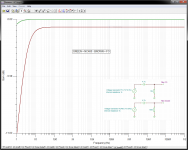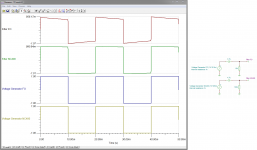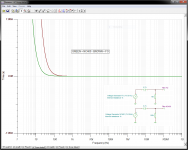you think with new gnd will sound better than floating?
one more question,what should i expect from burn in?
they have work less than 10 hours.
Of course it will sound better according to sch from #838
Hehehe 10 hours, 40 or more needed for proper burn in and elcos to form

but according to post 851 completely isolated sound better.Of course it will sound better according to sch from #838
Hehehe 10 hours, 40 or more needed for proper burn in and elcos to form
p.s.there is room for improvement yet
p.s.2any recommendations for power cable from psu to amps?now i have cheepo 1.5mm.
Well, some remarks. What we feel like "defined" is often the result of things that happens elsewhere than in low frequencies (Dynamic and transients of attacks).Many times people confuse bass quality with quantity, a lot of boomy, loosey, undefined bass only seems to be more present, also in a passages where it shouldn't be present, actually it is just less defined, lower quality.
Results, too, can be very different, depending of the way boomers are acoustically damped, the damping factors of the amps, and the best one in one situation can be the worse in an other.
Last, the evils of class D amps are far away in low frequencies, and they can have some advantages with their high feedback ratio (or the contrary as well). I prefer them for *my sub* in multi amplification. (But i prefer your VSSA everywhere else ;-)
Oh, I never try to evaluate basses before a LONG burn-in, listening music. I thing even 50 hours is not enough and a week was not even definitive in 10 hours a day of studio work at high levels.
Last edited:
but according to post 851 completely isolated sound better.
Yes still, but post #838 shows GND wire connection between SMPS-s, not modules. Both DRD circuits can be lifted for complete GND isolation.
In user's manual, regular stereo connection shows GND wire connection between modules, it works fine but sch from post #838 is better.
1,5 mm2 is OK for PSU connection, internal input cable should be CAT6 solid core twisted pair for best result.
Yes still, but post #838 shows GND wire connection between SMPS-s, not modules. Both DRD circuits can be lifted for complete GND isolation.
In user's manual, regular stereo connection shows GND wire connection between modules, it works fine but sch from post #838 is better.
there is no connection between psu,s they are mono.if i want to do that i will need a cable 2m+ because each mono will go behind the speaker.
you think i should do it?
Last edited:
so there was no DSP and you compared undsp-ed amps, no wonder you could hear differences

no alpine was used as a dac/pre
"i've tried many amps with my speakers, the nc400 is so far ahead on the bass than other respectable amps"
exactly.
Silver cables have the same effect. Bass is low, strong, has incredible slam and speed. Unfortunatelly the rest of the frequency spectrum is like watching through thick glass.
Some like it some don't.
Igor
Member back a quick look data for NC400 it has 10 x higher input impedance than FO, then if your pre not DC coupled but has a cap in output make this 10 x bigger in value, or try a DC coupled pre and compare with both amps.
i don,t know why should this do any difference since the -f3 will be under 5hz with both amps.
i don,t even know why we give so much importance to it.
my f.o is not even burned in not with the tightest cable connections and with
low sensitivity speakers.
even if ncore is better why should the f.o. be the best amp ever?
besides ncore have a d.f. of 11.000
i don,t know why should this do any difference since the -f3 will be under 5hz with both amps.
Maybe your DSP has high output impedance, so not optimally adopted to the First One and there you get low signal on low octave. As I remember the bass was the weak side of the NC400 and one of the reasons I sold it, also high spectrum was a little bit harsh, so no regrets left behind.
Can-you be more detailed ?tested against ncore nc400. F.O indeed sounds better except the bass.
Sometimes, even our ears need some burnin to accommodate a new system sound in a well known environment ;-)
Square wawes in lowsi don,t know why should this do any difference since the -f3 will be under 5hz with both amps......
You right......i don,t even know why we give so much importance to it.
my f.o is not even burned in not with the tightest cable connections and with
low sensitivity speakers.
even if ncore is better why should the f.o. be the best amp ever?
.....
Huge dampening control......besides ncore have a d.f. of 11.000
Last edited:
besides ncore have a d.f. of 11.000
How does damping factor sound?
Why does some miliohm output impedance have influence on sound when used with more than miliohm speaker cables.
Has anyone tried just listening to different lenghts of awg24 utp as speaker cables? Comparing 0.5 m vs 2 meters? Damping factor difference is huge, the sound is almost similar.
Igor
Damping factor is not generated by a passive internal resistance in the amplifier.Has anyone tried just listening to different lenghts of awg24 utp as speaker cables? Comparing 0.5 m vs 2 meters? Damping factor difference is huge, the sound is almost similar.
It is an effect of feedback, and the output impedance of an amp can even be...negative.
It works on creating an opposite signal to the one generated by the speaker's unwanted movements. The (very little) resistance of the speaker's cable (r) just add its impedance to the speaker's one (R) where the amp internal value is (Dr).
The bridge for the currents is Dr/(R+r+Dr) where you can see the little influence of r.
Maybe your DSP has high output impedance, so not optimally adopted to the First One and there you get low signal on low octave. As I remember the bass was the weak side of the NC400 and one of the reasons I sold it, also high spectrum was a little bit harsh, so no regrets left behind.
i think you have it right.just checked the alpine,s specs and output impedance is 1k.
it,s a bit high for 10k input of f.o.
but the bass is the weak side of nc400?no way everybody that have heard it said it,s the stong side.
maybe it,s too much control for your speakers.
SIM
SIM roughly signal presented input at FO / NC400.
Signal generator output z set to 1K all plots for simulating preamp, and ac cap value just a guess.
Squarewaves (50Hz) and group delay speed at lows could be done equal for both amps by using ten times bigger cap when used with FO, for amplitude F3 will equal too but dB total level into FO heavier 10K load verse 100K load NC400 still be lesser, influenced by source having 1K z out.
SIM roughly signal presented input at FO / NC400.
Signal generator output z set to 1K all plots for simulating preamp, and ac cap value just a guess.
Squarewaves (50Hz) and group delay speed at lows could be done equal for both amps by using ten times bigger cap when used with FO, for amplitude F3 will equal too but dB total level into FO heavier 10K load verse 100K load NC400 still be lesser, influenced by source having 1K z out.
Attachments
Last edited:
- Home
- Vendor's Bazaar
- First One - mosFET amplifier module


